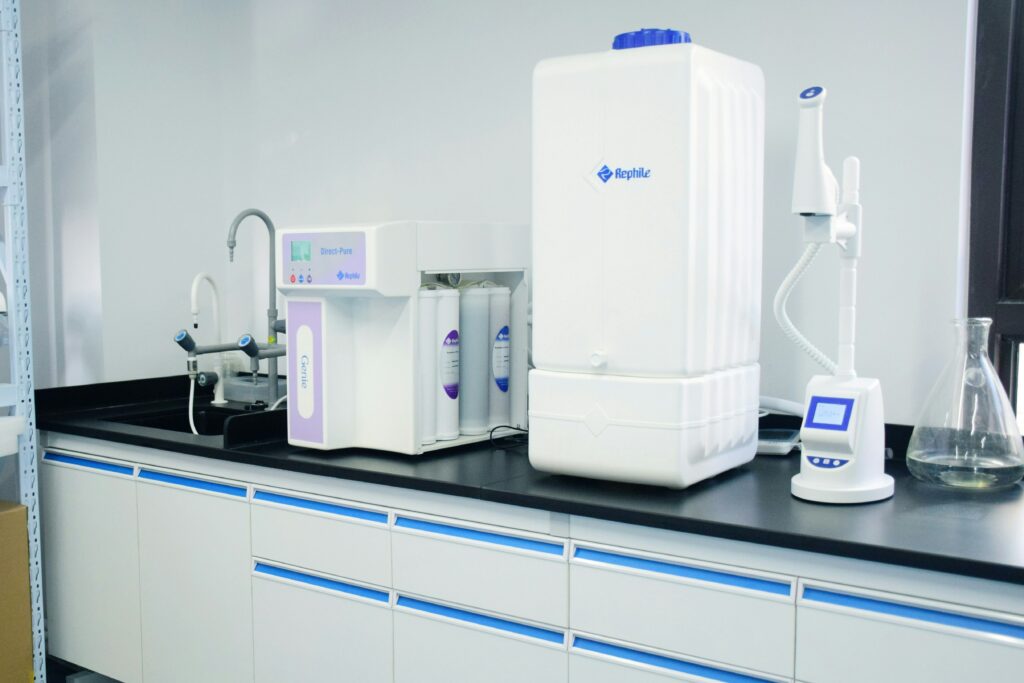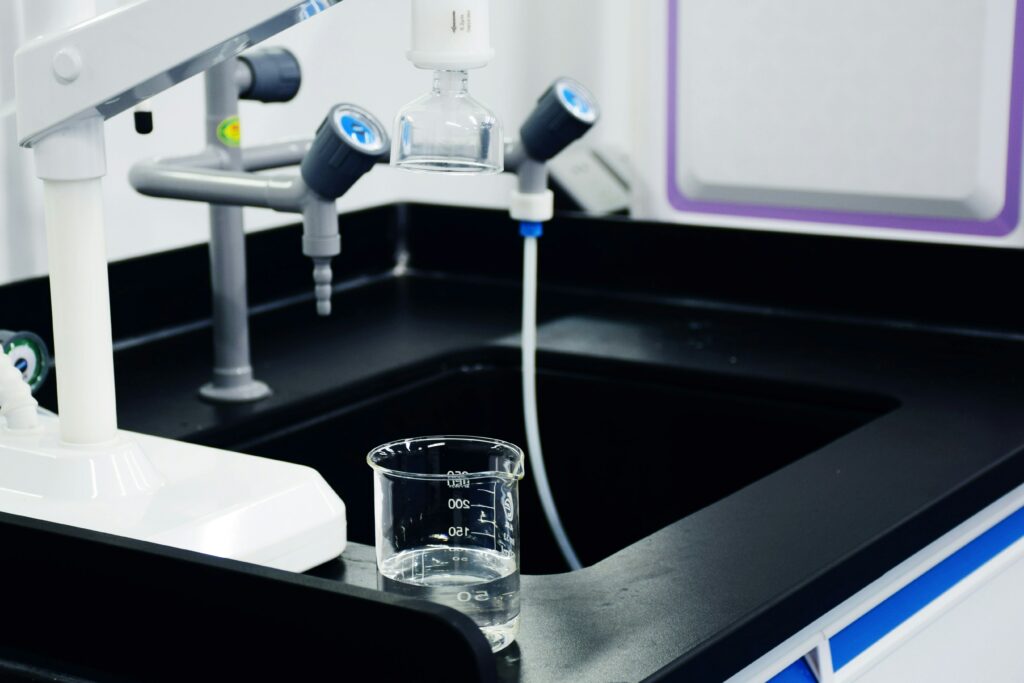Nitric acid (HNO3) is a strong, colorless to pale yellow, highly corrosive mineral acid used as a chemical reagent and raw material in many industrial applications. This essential chemical compound is used in various industrial and scientific fields. Thanks to its unique physical and chemical properties, it plays a central role in the manufacture of fertilizers, explosives, and many other chemical products. The determination of nitric acid (HNO3) is crucial to ensure the quality of formulations and compliance with safety standards. This article explores nitric acid in depth, starting with its fundamental characteristics and history, then detailing its synthesis methods, uses, and physicochemical analyses for characterizing it in the laboratory.
1. What is nitric acid?
Definition and chemical formula
Nitric acid, with the chemical formula HNO3 , is a strong mineral acid composed of hydrogen (H), nitrogen (N), and oxygen (O). It is a colorless liquid when pure , but often takes on a yellowish or reddish due to its partial decomposition into nitrogen dioxide (NO2) . Highly reactive, it dissolves readily in water to form acidic solutions. Its molar mass is 63.01 g/mol , making it relatively light compared to other mineral acids.
Physical properties of nitric acid
Nitric acid has distinct physical properties:
- Melting temperature : -41.6°C
- Boiling temperature : 121°C for a 70% concentrated solution.
- Density : 1.4 g/cm³ (70%).
- Saturated vapor pressure : 6.4 kPa at 20°C.
In concentrated solution, nitric acid gives off white or red , depending on the presence of nitrogen oxides. When it exceeds 86% concentration , it becomes " fuming nitric acid ", a particularly reactive form used in specific applications, such as rocket propellants.
Chemical properties and acidity
Nitric acid is a strong acid , with a pKa of -1.37 , which means that it dissociates almost completely in aqueous solution. The dissociation reaction can be written as:
HNO3 → H+ + NO3
Its nitrate ion (NO3⁻) is very stable and plays a key role in many chemical reactions. As a strong oxidizing , nitric acid can react with a wide range of compounds, including metals, carbides, and even some organic compounds. Unlike other acids such as hydrochloric acid, it does not release hydrogen gas when reacting with metals, but instead produces nitrogen oxides .
2. The Ostwald process: modern industrial production
The Ostwald process, developed in 1902 by the German chemist Wilhelm Ostwald , is today the most common industrial method for producing nitric acid. This method is based on the oxidation of ammonia (NH3) in the presence of a catalyst, usually platinum rhodium , and takes place in three main stages:
Oxidation of ammonia to nitric oxide
Gaseous ammonia reacts with oxygen at high temperature ( 850°C ) and under moderate pressure in the presence of the catalyst. This reaction releases nitrogen monoxide (NO) and water:
4 NH3+5 O2→ 4 NO+6 H2O
exothermic reaction , which releases a significant amount of heat used to optimize the energy efficiency of the process.
Oxidation of nitric oxide to nitrogen dioxide
The nitrogen monoxide formed is then cooled and oxidized to nitrogen dioxide (NO2) by reaction with oxygen in the air:
2 NO + O2→2 NO2
This step takes place at a lower temperature, around 50°C , to promote the formation of nitrogen dioxide.
Absorption of nitrogen dioxide in water
Finally, nitrogen dioxide is dissolved in water to produce nitric acid and nitric oxide:
3 NO2+H2O → 2 HNO3 +NO
The resulting nitric oxide is recycled back into the process to improve overall efficiency. The nitric acid obtained from this process typically has a concentration of 60 to 68% . For higher concentrations, distillation in the presence of sulfuric acid are used.
The Ostwald process achieves an efficiency of approximately 96% , making it both economical and efficient. It revolutionized the modern chemical industry by making possible the mass production of nitric acid for a variety of applications.
Laboratory synthesis: small-scale production
In the laboratory, nitric acid is often produced by the reaction between a metal nitrate (such as potassium nitrate, KNO3) and concentrated sulfuric acid ( H2SO4) . The mixture is gently heated to release nitric acid vapors, which are then condensed:
KNO3+H2SO4 → HNO3 + KHSO4
This process, although less efficient than the Ostwald process, allows small quantities of pure nitric acid to be obtained. Depending on the reaction conditions and temperature, it is possible to obtain white or red fuming nitric acid. The latter contains dissolved nitrogen oxides which give it its characteristic color.
Alternative methods and modern techniques
Although the Ostwald process dominates industrial production, alternative methods exist:
- Reactions with natural nitrates : Historically, nitric acid was extracted from nitrates present in natural deposits such as Chilean saltpeter (NaNO3). This method has been largely abandoned due to its high cost.
- Electrochemical methods : Some research is exploring electrochemical processes using air or nitrogen as raw materials to directly produce nitric acid. Although promising, these techniques are still in the experimental stage.
Concentration and purification of nitric acid
Nitric acid produced by industrial methods often contains water and impurities. To obtain concentrations above 68% (azeotrope with water), distillation is necessary in the presence of concentrated sulfuric acid, which acts as a dehydrating agent.
To obtain fuming nitric acid, the product is treated to reduce the amount of water and remove dissolved nitrogen oxides . There are two types of fuming nitric acid:
- White fuming nitric acid : Practically free of water and nitrogen oxides.
- Red fuming nitric acid : Contains a significant amount of nitrogen oxides, which gives it its reddish color.

3. Industrial uses of nitric acid
Production of nitrogen fertilizers
Nitric acid is mainly used for the production of nitrogen fertilizers , a sector that accounts for about 75% of its global consumption. By reacting with ammonia (NH3), it allows the synthesis of ammonium nitrate (NH4NO3) , a fertilizer widely used in agriculture for its high nitrogen content. Here is the simplified chemical reaction:
NH3 + HNO3 → NH4NO3
Ammonium nitrate is particularly valued for its ability to provide nitrogen to plants quickly and efficiently. It is also the basis of other fertilizers such as calcium nitrate (Ca(NO3)2) and potassium nitrate (KNO3) .
Production of explosives
Nitric acid plays a fundamental role in the synthesis of high explosives due to its ability to nitrate organic compounds. Among the most common explosives produced from HNO3 are:
- Nitroglycerin : Obtained by reaction between glycerin and nitric acid, it is used in the manufacture of dynamite.
- Trinitrotoluene (TNT) : Produced by nitration of toluene, it is an explosive widely used in the military and mining industries.
- Picric acid : Used in munitions, it is synthesized by nitration of phenols.
Nitric acid is therefore central to the explosives industry, highlighting its strategic importance in the defense and mining sectors.
Applications in metallurgy and microelectronics
Nitric acid is an essential reagent in metallurgy for the treatment and purification of metals. It is used for:
- Metal stripping : Nitric acid removes oxides and impurities from the surface of metals such as copper, silver and brass.
- Chemical etching : In the microelectronics industry, it is used to etch printed circuits and clean electronic components.
- Metallurgical analysis : HNO3 is used in qualitative and quantitative tests to identify metallic components in alloys.
Its reactivity also allows it to dissolve metals such as silver and copper, forming water-soluble metal nitrates.
Synthesis of chemicals and intermediates
Nitric acid is used in the synthesis of many chemical products used in various sectors:
- Dyes and pigments : HNO3 is involved in the manufacture of organic dyes by nitration of aromatic compounds.
- Pharmaceuticals : It is used in the production of chemical intermediates for drugs.
- Plastics and polymers : Nitric acid is used in the synthesis of precursors for the manufacture of materials such as nylon.
Its role in these processes is a testament to its versatility and importance to modern industrial chemistry.
Use in the cosmetics industry
Nitric acid is used in the cosmetics industry, particularly for the treatment of raw materials and packaging. It allows:
- Purification of cosmetic components to remove residual impurities.
- Packaging material testing : It is used in migration tests to verify that packaging does not transfer harmful substances into finished products.
These applications ensure the safety and quality of cosmetic products while respecting current standards.
Role in the aerospace industry
Nitric acid is used as an oxidizer in rocket propulsion. In the form of inhibited red fuming nitric acid (IRFNA) , it is mixed with fuels such as UDMH (unsymmetrical dimethylhydrazine) to form hypergolic liquid propellants . This reaction releases a large amount of energy, making it an ideal choice for missile and satellite propulsion.
Are you looking for an analysis?

4. Chemical reactions involving nitric acid
Nitric acid is recognized for its exceptional chemical properties, including its oxidizing and its ability to react with many organic and inorganic substances. These characteristics make it a central reagent in several essential chemical reactions in the laboratory and industry.
Action of nitric acid on metals
Unlike other strong acids such as hydrochloric acid, nitric acid does not release hydrogen gas (H2) when reacting with metals. This characteristic comes from its oxidizing , which promotes the formation of metal nitrates and nitrogen oxides (NO, NO2).
The overall reaction between a metal M and nitric acid HNO3 can be expressed as follows:
8n HNO3 + 6M → 6M(NO3)n + 2nNO + 4nH2O8
where n is the valence of the metal (1, 2 or 3).
Reactive metals : Metals such as copper, zinc, iron, or silver react readily with dilute nitric acid to form soluble metal nitrates . For example, the reaction with copper gives:
3 Cu + 8HNO3 → 3Cu(NO3)2 + 2 NO + 4 H2O
Formation of nitrogen oxides : Depending on the concentration of nitric acid, different nitrogen oxides can be produced. With concentrated nitric acid, nitrogen dioxide (NO2) is the main gaseous product, which gives the reaction its fuming character.
Passivation of certain metals : Some metals such as aluminum , chromium and iron become covered with a thin layer of oxide when they come into contact with concentrated nitric acid. This phenomenon, called passivation , protects the metal from further corrosion.
Nitration reactions with organic compounds
Nitric acid is central to nitration , a process where a nitro group (-NO2) is introduced into an organic molecule. These reactions are often catalyzed by concentrated sulfuric acid, which increases the activity of nitric acid.
- Nitration of benzene : Benzene reacts with a mixture of nitric acid and sulfuric acid to form nitrobenzene
- Nitration of alcohols : Nitric acid can oxidize primary alcohols to form carboxylic acids . For example, the oxidation of methanol gives formic acid.
These reactions are essential for the production of explosives (TNT, nitroglycerin), dyes and other industrial organic compounds.
Reactions with non-metallic compounds
Nitric acid also reacts with non-metallic substances to produce oxides or derivative acids. For example:
- With sulfur (S), it forms sulfuric acid (H2SO4)
- With carbon (C), it gives carbon dioxide (CO2)
These reactions demonstrate the exceptional oxidizing power of nitric acid, capable of transforming simple compounds into oxidized products.
Reactions involving aqua regia
Nitric acid, when mixed with hydrochloric acid in a ratio of 1:3 , forms a solution called aqua regia . This solution is one of the few reagents capable of dissolving noble metals such as gold and platinum .
Aqua regia is used in metallurgy , particularly for the recovery of gold from electronic waste or for analytical applications.
Formation of nitrates
Nitric acid plays a key role in the formation of nitrates , salts derived from the nitrate ion (NO3⁻). These nitrates are used in various industrial and agricultural applications:
- Ammonium nitrate (NH4NO3) : Agricultural fertilizer and component of explosives.
- Silver nitrate (AgNO3) : Used in photography and medicine.
- Potassium nitrate (KNO3) : Used in the manufacture of gunpowder and as a food preservative.
5. Laboratory analysis of nitric acid
Laboratory analysis of nitric acid is crucial to ensure its quality, concentration, and compliance in industrial and environmental applications. Laboratories use precise methods to detect and quantify this acid, whether in air, aqueous solutions, or industrial materials.
Sampling techniques
Sampling is a critical step in obtaining reliable analytical results. Techniques vary depending on the matrix (air, water, or solution) in which nitric acid is to be detected.
Air sampling
- Nitric acid vapors present in the air are collected using filters impregnated with Na₂CO₃ (sodium carbonate). These filters trap nitrate ions (NO₃⁻), which are then analyzed in the laboratory.
- Sampling devices include filter cassettes quartz or PTFE pre-filters for improved absorption.
- The recommended sampling flow rate is approximately 2 L/min , with a duration that can vary from 15 minutes to 120 minutes depending on the objective of the analysis.
Sampling in aqueous solutions
To analyze nitric acid dissolved in water or other solutions, samples are collected in sealed, inert vials Glass or HDPE (high-density polyethylene) containers are preferred to maintain the chemical integrity of the sample.
Methods of analysis of nitric acid
Laboratories have several analytical techniques to accurately measure nitric acid concentration.
Ion chromatography (IC)
Ion chromatography is the most widely used method for analyzing nitrate ions (NO₃⁻) resulting from the dissociation of nitric acid in solution.
- Principle : The anions are separated on an ion exchange column , then detected by a conductometric detector .
- Equipment : Ion chromatograph equipped with a specific column such as AS22 with automatic suppression to reduce interferences.
- Limit of Quantification (LOQ) : Generally in the order of 0.5 to 2 µg/sample , which allows extremely low concentrations to be analyzed.
Acid-base titration
This simple method relies on neutralizing nitric acid with a strong base such as sodium hydroxide (NaOH). A colored indicator or potentiometric measurement is used to determine the equivalence point.
Reaction equation :
HNO3 + NaOH → NaNO3 + H2O
This method is particularly effective for solutions containing high concentrations of nitric acid.
UV-Visible Spectroscopy
Nitric acid can be analyzed by UV-Visible spectroscopy due to the characteristic absorption of nitrate ions (NO₃⁻) in the ultraviolet region.
- Absorption wavelength : About 220 nm .
- Advantage : Fast method suitable for simple aqueous solutions.
Colorimetric methods
For environments where complex equipment is not available, colorimetric methods are used. These methods rely on the reaction of nitrate ions with chemical reagents to form a colored complex, measured using a spectrophotometer .
Analysis of nitric acid in air
Nitric acid analysis in air is particularly important in industrial and environmental to monitor air quality and prevent health risks. The most commonly used method is ion chromatography , preceded by sampling on specific filters.
- Steps of analysis :
- Samples are collected on filters impregnated with sodium carbonate.
- The filters are then placed in an aqueous solution to extract the nitrate ions.
- The extract is analyzed by ion chromatography to quantify the HNO3 concentration.
This method offers high accuracy and sensitivity , with detection limits down to 0.5 µg/m³ .
Quality control and accuracy of results
To ensure reliable analytical results, laboratories implement quality control (QC) procedures :
- Use of control samples to assess possible contamination.
- Analysis of method blanks to eliminate interferences.
- Carrying out regular calibrations of instruments with certified calibration solutions.
- Validation of results by repetitions and precision measurements.

6. Handling precautions and associated risks
Nitric acid, due to its high acidity oxidizing properties , is a hazardous substance that must be handled with care. It poses significant risks to human health, operator safety, and the environment. This section details the main hazards associated with nitric acid and the precautions necessary to ensure safe handling.
Health risks
Nitric acid is toxic and corrosive , causing serious effects when it comes into contact with skin, eyes, or is inhaled. The main risks include:
Skin and eye burns
- severe chemical burns on skin contact . Skin often turns yellow due to the acid reacting with keratin .
- Splash in the eyes can cause severe irritation , permanent eye damage, or even loss of vision with prolonged exposure.
Inhalation of vapors
Nitric acid vapors, especially those from fuming nitric acid, are irritating to the respiratory tract. Acute exposure can cause:
- Coughing and difficulty breathing .
- Pulmonary edema , which can be fatal if inhaled in high concentrations.
Systemic effects
Accidental ingestion can cause burns to the esophagus and stomach , severe abdominal pain, and internal bleeding complications.
Chemical and environmental risks
Nitric acid is a powerful oxidizing , which increases the risks when it comes into contact with certain substances:
- Explosive reactions : It reacts violently with organic materials such as solvents (ethanol, acetone), metal powders and carbides .
- Ignition : Latex or nitrile gloves may ignite spontaneously upon contact with concentrated nitric acid.
- Environmental impact : In the event of a spill, nitric acid can contaminate water, acidify soils and cause damage to flora and fauna.
Precautions to take when handling
To reduce the risks associated with the use of nitric acid, it is essential to apply strict safety measures :
Personal Protective Equipment (PPE)
- Wear a chemical-resistant lab coat , appropriate butyl or neoprene gloves, and safety glasses with side shields.
- Use a face shield to protect the face during high-risk handling.
- Work under an extractor hood to avoid inhaling toxic fumes.
Safe handling
- Handle nitric acid carefully, using automatic pipettes or suitable dosing equipment to avoid splashing.
- Never pour acid into a container containing water. It is essential to add the acid slowly to the water to prevent splashing due to the heat generated.
- Clearly label all containers containing nitric acid to avoid confusion with other substances.
Proper storage
- Store nitric acid in containers made of glass or resistant materials, such as polytetrafluoroethylene (PTFE) .
- Store cylinders in a cool , dry , ventilated , away from combustible materials and reducers.
- Avoid contact with other acids, bases or incompatible chemicals.
Leak and Spill Management
In the event of a leak or spill, immediate action must be taken:
- Evacuate unauthorized personnel from the contaminated area.
- Neutralize the acid with a basic solution , such as sodium bicarbonate or lime.
- Absorb liquid with inert absorbent materials, such as vermiculite or dry sand.




